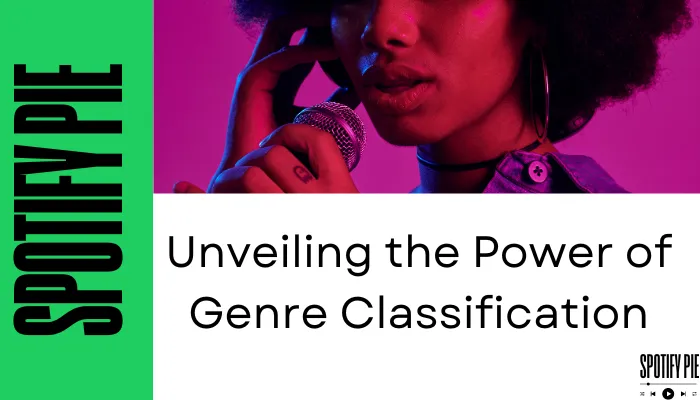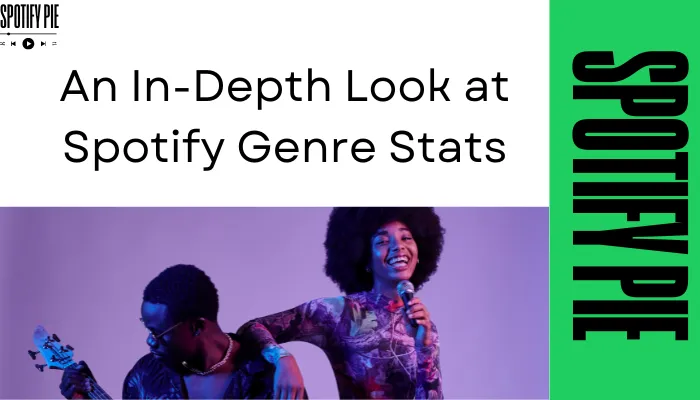In today’s digitally driven music landscape, Spotify genre stats have become the unchallenged king.

Spotify, as a leading global music streaming platform, gives its vast library of millions of songs to its diversified audience with diverse musical tastes.
However, for artists, listeners, and even Spotify itself understanding these preferences is key to not only effectively navigating the platform but also creating content that will attract users. This is where Spotify genre stats come into play.
Why Do Spotify Genre Stats Matter?
Genre classification in the music industry plays a crucial role because:
- Artists: By analyzing Spotify genre stats, artists are provided with insights about listener demographics and popular subgenres within their chosen genre. This way, they can adjust their sound and marketing strategies so as to reach a bigger fan base or establish themselves within a particular niche.
- Listeners: Genre stats give listeners the power to search for new tracks that they might love. Accessing valuable data makes it easier to discover hidden gems in your favorite genre or step out of your comfort zone.
- Spotify: Understanding genre trends enables Spotify to improve personalized recommendations, enhance search algorithms, and develop targeted marketing campaigns that retain existing users while attracting new ones.
Unveiling the Power of Genre Classification
Spotify categorizes music with extreme precision across numerous genres and sub-genres. It helps fans organize playlists and find similar musicians within this intricate system.

Say you want some “relaxing music,” searching on Spotify would give you access to ambient playlists– all thanks to genre classification magic!
However, the digital age has brought about the cross-pollination between traditional genres. Modern-day artists have become professionals at blending different styles together thus creating unique fusions.
Henceforth, Spotify’s genre classification system adjusts continually for this dynamism allowing individuals to obtain their desired tunes despite unbending limits imposed by various genres.
Top Spotify genre stats
Let’s delve into the heart of the matter: Spotify genre stats. Here, we’ll explore the most popular genres based on listener count:
| Genre | Description |
|---|---|
| Pop | Pop music is a perennial favorite on Spotify, with the greatest number of listeners among all other genres. It is liked by people from different parts of the world due to its general appeal and catchy tunes. |
| Hip Hop/Rap | Hip hop and rap have found their place on Spotify, especially with young age groups. The genre’s storytelling approach, social relevance, and rhythmic intricacies appeal to a broad spectrum of people. |
| Rock | Rock still features prominently on Spotify as one of popular music’s staples. Whether it’s classic rock, alternative rock, or indie rock, it has remained attractive to its audience, evolving daily to meet changing tastes. |
These are just some examples but looking at Spotify genre stats paints a vivid picture of diverse musical preferences.
The Ever-Shifting Landscape of Genre Popularity
Genre trends are not static. Over time, Spotify genre stats offer an evolving insight into consumer behavior related to music tastes. Some factors include:
- Cultural movements: Social and cultural movements can serve as catalysts for certain genres’ popularity. For example, K-Pop’s rise over recent years confirms that global events do play a large part in determining what people prefer to listen to.
- Technological advancements: Music streaming sites like Spotify have made it easier for minor sub-genres to find followers. Unknown artists can now access global markets thereby propagating once marginalized styles into popularity.
- Nostalgia: So, retro trends keep coming back into fashion. The stats for Spotify genres can tell us something about the popularity of genres like 80s synth-pop or 90s grunge and this is driven by nostalgia.
Is Stats for Spotify Safe?
Stats for Spotify genres are useful to music enthusiasts as well as industry insiders. Despite this, many worry about the security of third-party apps requiring access to your Spotify data. Here are some ideas that will help you use stat-tracking tools more safely:
Stick with official Spotify tools: Go straight to the Spotify app whenever possible and get your listening “stats” there.
Check out reputable third-party apps: Read reviews before handing over access to your music data from Spotify; check if a given app has a good reputation in terms of data safety
Permissions matter: Ensure you go through any permission request made by a third-party app carefully so that only vital information needed to run it is shared.
By abiding by these rules, you can maximize the benefits of Spotify genre statistics while protecting your integrity. In summary, we find a reservoir of knowledge in Spotify genre stats on the ever-changing music scene.
An In-Depth Look at Spotify Genre Stats
Music shapes our emotions, triggers memories, and connects us with other cultures. But have you ever thought about how these tastes differ from country to country?

Spotify, the world’s largest music streaming platform, has a wealth of knowledge on listening trends and patterns; this data offers thrilling insights into regional genre preferences, sub-communities flourishing within genres, and how genres determine the success rates for artists. This article explores the world of Spotify genre stats answering:
How Genres Travel the World?
While music knows no borders as such geographical inclination reveals cultural influences more vividly. Here is how Spotify genre statistics expose listening habits worldwide:
- Pop Dominates: Even around the world pop music is still king with its catchy tunes and hits that top charts globally.
- Regional Rhythms: Regional genres still hold their ground even though pop is dominating. For example, K-pop dominates South Korea and parts of Southeast Asia while Latin American Music thrives in Central and South America.
- Genre Mash-Ups: Another recent trend spotted by Spotify stats is genre-bending music where fusion between electronic dance music (EDM) and either pop or rock comes up with a unique tune played across different audiences.
The Power of Subcultures on Spotify
Spotify isn’t just limited to mainstream music. The platform hosts diverse subgenres that cater for specific preferences by offering passionate communities an opportunity to flourish. We will now explore these microcosms’ potential:
A Universe of Subgenres: Whether it may be the dark atmospheric sounds of lo-fi hip hop or the high-energy beats from drum and bass, Spotify provides a home for niche genres. Such subgenres reflect certain moods and interests, creating a sense of belonging to their loyal listeners.
Discovery Through Playlists: Niche genres can be discovered through curated playlists on which users may find vaporwave, chiptune (music inspired by 8-bit video games), and black metal among others. It helps widen their musical exposure.
Artist-to-Fans Connection: These musicians are supported by Spotify algorithmic recommendations which help them reach out to people with similar music tastes thereby promoting community spirit among them.
How Do Genres Impact Artists on Spotify?
Artists trying to find their way around the platform must understand how genres work on Spotify. Here is how genre stats could affect an artist’s success:
- Genre Visibility: Most times, Spotify navigation features group music into different genres. An artist can maximize his or her chances of being frequently displayed in such lists and recommended if they purposefully select some specific genre focus areas where they want to concentrate.
- Genre Bending with Caution: However, experimentation within a genre is necessary but going too far away from that will lose your core audience. Understanding what makes up a particular genre while adding some personal touch can lead one into winning strategies.
- Genre-Specific Playlists: An artist’s placement on any of the genre-specific playlists curated either by Spotify editors or influenced has a tremendous impact on expanding their reach and increasing exposure level.
Is Stats for Spotify Safe?
In order to avoid third-party apps or websites that analyze statistics about streaming from Spotify it is essential to ensure that they are secure. Below are things an individual must keep in mind when considering this.
- Check Reviews and Look for Permissions: Research what other users have to say about the app, and ensure that it only asks for permissions that your data.
- Stick To The Right Sources: Spotify company itself provides insights into this through their year-end feature “Wrapped” which shows your listening habits and personalized playlists.
By knowing Spotify genre stats, music enthusiasts can embark on a worldwide journey of sound; they can discover new sounds and connect with vibrant communities. For artists, this knowledge is a powerful tool in navigating the platform to reach out to their loyal fans.
Therefore, put on your headphones, explore the world of genres on Spotify, and open up a whole universe of musical experiences!
Unveiling Spotify Genre Stats and How They Shape Music Consumption?
Music is a universal dialect; yet, our tastes within that dialect can be as varied as that of listeners. Spotify is the world’s number one music streaming service with an enormous library catering to an equally diverse audience. But what are we listening to?
How do age, gender, and location determine our genre preferences? This article delves into Spotify genre stats revealing the intriguing correlation between demographics and music consumption habits.
Demystifying the Data
Knowing the most popular genres on the platform does not fully describe the understanding of Spotify genre stats. It’s about getting to know why we prefer certain kinds of music over others. Here’s where age, gender, and other demographic factors come into play:
| Demographic | Description |
|---|---|
| Age | Teens and Young Adults (13-25): In general, this population favors Pop Music, Hip-Hop, and EDM. The energetic tones coupled with infectious hooks resonate well with their vibrant enthusiasm. Young Adults (26-35): As people mature in life, so do their preferences in culture. Although pop remains dominant, some alternative rock genres like Indie Rock or Alternative Rock have gained popularity. Adults (36-55): Life priorities change, and so do music choices. This group of people mostly prefers hearkening back to past sounds for comfort reasons. Classic rock acts from yesteryears or even country records from their formative years may become popular again. Mature Adults (55+): Nostalgia rules here. Genres such as Classic Rock, Oldies, and Folk experience a significant rise in listenership. |
| Gender | Urban Areas: Exposing to many cultures results in a wider range of popular music genres with hip-hop and EDM being the most common. Rural Areas: These areas still adhere strongly to Country music while Rock and Pop hold sway too. |
| Location | Urban Areas: Exposing to many cultures results in a wider range of popular music genres with hip-hop and EDM being the most common. Rural Areas: These areas still adhere strongly to Country music while Rock and Pop hold sway too. |
Unveiling the “Why” Beyond Demographics
However, the reasons behind these preferences are manifold as Spotify genre stats reveal:
Nostalgia: Familiar genres bring up memories and feelings that offer comfort and connection to a place where one belongs.
Cultural Identity: Music can be a powerful emblem of cultural identity. Genres linked with certain ethnicities or communities can create a sense of belongingness.
Mood and Activity: Upbeat pop or thumping EDM may boost your workout while calm classical or soothing acoustic playlists are ideal for winding down.
Social Influence: Music trends as well as recommendations from peers or coming from social media influence listening patterns.
Implications for the Music Industry
The importance associated with knowing Spotify genre stats becomes apparent in the music industry:
- Targeted Marketing: This knowledge enables artists or record labels to tailor marketing strategies that will reach out to specific target demographics through those genres they associate with.
- Content Creation: Genre preferences should determine what types of music are produced so that it cater to changing listener tastes.
- Platform Development: With knowledge about what people listen to, Spotify can give personalized recommendations and curate playlists based on individual preferences.
Conclusion
This exploration is just the tip of the iceberg. As Music continues to change and our tastes with it, Spotify genre stats will offer richer insights into a changing world of music.
The genre statistics of Spotify create an interesting image of music habits. By digging into demographics and the “why” behind our choices, the music business can not only pander to existing trends but also anticipate and shape the future of music.
This article has been like a gateway into further investigation of Spotify genre stats. But remember; life is a journey and exploring the data behind our listening habits only enriches it more. So wear your headphones and press play: let’s see where this takes us!
